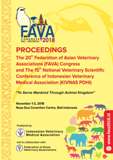FA-5 Semen Characteristics of Banteng (Bos javanicus) Collected by Electroejaculation Method
Abstract
Banteng (Bos javanicus) is listed as endangered species in IUCN Redlist. Only few thousand wild banteng survive and their numbers are decreasing as a result of hunting and the loss of habitat due to deforestation and conversion to agricultural land. One of the conservation measures is to preserve this species in ex-situ breeding center. The breeding centre with the largest number of individuals is Ragunan Zoo in Jakarta, with 21 animals. Despite those numbers of individuals available, the sex ratio was far from ideal at 16 males and five females. While in Taman Safari Prigen, there were with 16 individuals and a sex ratio of five males and 11 females [1] Since number of males are usually less than females, and also to avoid inbreeding in order to keep high heterozygosity population, therefore, assisted reproductive technology such as artificial insemination is considered to be necessary.
For artificial insemination, semen collection sufficient quantitiy and quality of semen from males are needed. Thus, best semen collection method should be considered. Though transrectal massage procedure does not require the male to be anesthetized prior to semen collection, semen collected by this technique contains urine contamination. Besides, volume of semen sample obtained by transrectal massage is lesser compared to electroejaculation. Electroejaculation is also suitable for wild animal because in this particular semen collection procedure, males are not required to be trained.
The information about semen characteristics of banteng bulls collected by electroejaculation is less known. To date, study done by Johnston et al. (2002) is the only available data. That study only provided data from one semen sample from one 4-year-old banteng bull located at Western Plains Zoo [2]. Moreover such volume parameter and consistency was not reported from that study. Thus, this study is aimed to provide more reliable data from larger number of semen samples collected by electroejaculation and to add information to previous data that are availabe.

